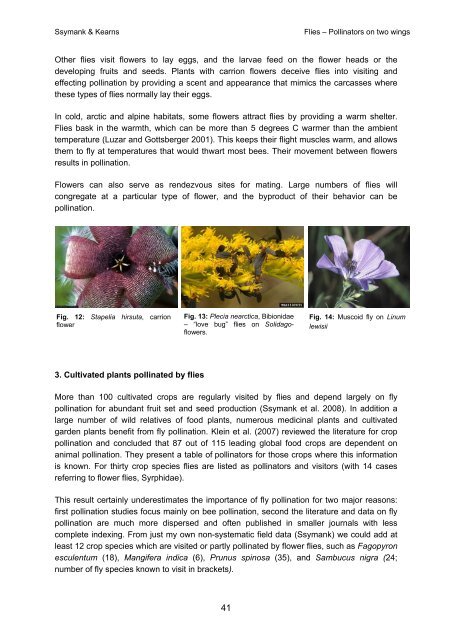Caring for Pollinators - Bundesamt für Naturschutz
Caring for Pollinators - Bundesamt für Naturschutz
Caring for Pollinators - Bundesamt für Naturschutz
You also want an ePaper? Increase the reach of your titles
YUMPU automatically turns print PDFs into web optimized ePapers that Google loves.
Ssymank & Kearns Flies – <strong>Pollinators</strong> on two wings<br />
Other flies visit flowers to lay eggs, and the larvae feed on the flower heads or the<br />
developing fruits and seeds. Plants with carrion flowers deceive flies into visiting and<br />
effecting pollination by providing a scent and appearance that mimics the carcasses where<br />
these types of flies normally lay their eggs.<br />
In cold, arctic and alpine habitats, some flowers attract flies by providing a warm shelter.<br />
Flies bask in the warmth, which can be more than 5 degrees C warmer than the ambient<br />
temperature (Luzar and Gottsberger 2001). This keeps their flight muscles warm, and allows<br />
them to fly at temperatures that would thwart most bees. Their movement between flowers<br />
results in pollination.<br />
Flowers can also serve as rendezvous sites <strong>for</strong> mating. Large numbers of flies will<br />
congregate at a particular type of flower, and the byproduct of their behavior can be<br />
pollination.<br />
Fig. 12: Stapelia hirsuta, carrion<br />
flower<br />
3. Cultivated plants pollinated by flies<br />
Fig. 13: Plecia nearctica, Bibionidae<br />
– “love bug” flies on Solidagoflowers.<br />
Fig. 14: Muscoid fly on Linum<br />
lewisii<br />
More than 100 cultivated crops are regularly<br />
visited by flies and depend largely on fly<br />
pollination <strong>for</strong> abundant fruit set and seed production (Ssymank et al. 2008). In addition a<br />
large number of wild relatives of food plants, numerous medicinal plants and cultivated<br />
garden plants benefit from fly pollination. Klein et al. (2007) reviewed the literature <strong>for</strong> crop<br />
pollination and concluded that 87 out of 115 leading global food crops are dependent on<br />
animal pollination. They present a table of pollinators <strong>for</strong> those crops where this in<strong>for</strong>mation<br />
is known. For thirty crop species flies are listed as pollinators and visitors (with 14 cases<br />
referring to flower flies, Syrphidae).<br />
This result certainly underestimates the importance of fly pollination <strong>for</strong> two major reasons:<br />
first pollination studies focus mainly on bee pollination, second the literature and data on fly<br />
pollination are much more dispersed and often published in smaller journals with less<br />
complete indexing. From just my own non-systematic field data (Ssymank) we could add at<br />
least 12 crop species which are visited or partly pollinated by flower flies, such as Fagopyron<br />
esculentum (18), Mangifera indica (6), Prunus spinosa (35), and Sambucus nigra (24;<br />
number of fly species known to visit in brackets).<br />
41

















